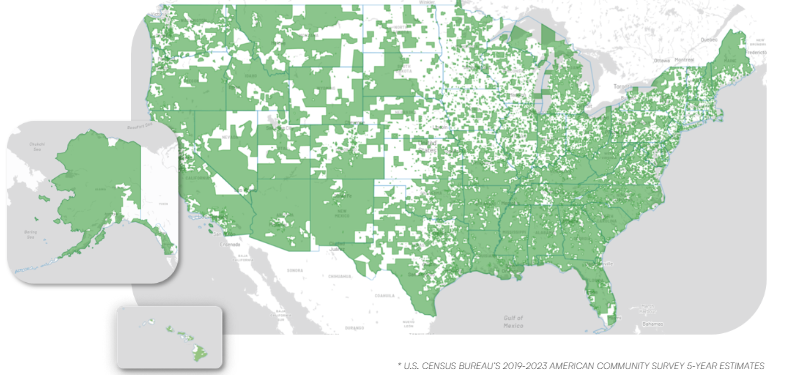Unlocking Growth: Why the Low-Income Designation Matters for Your Credit Union
Discover how the NCUA's Low-Income Designation opens doors to secondary capital, grant funding, and strategic growth opportunities that help credit unions compete in a consolidating industry.


Credit unions face mounting pressure from consolidation, rising operational costs, and increasingly complex regulations. The numbers tell a sobering story: from nearly 24,000 credit unions in 1970 to fewer than 4,800 today, the industry has contracted by more than 80%. For institutions still standing, the question is not just survival but how to grow sustainably in an environment where scale confers real advantages.
One often overlooked tool is the Low-Income Designation (LID) from the National Credit Union Administration. This designation unlocks specific regulatory benefits that can help credit unions compete more effectively, regardless of size. Yet many institutions struggle to obtain it or maintain it, largely because the requirements feel like a moving target.
In this article, we will cover:
- Why credit unions with LID outperform their peers
- The specific benefits that come with the designation
- The pathways to obtaining and maintaining LID
- How data analysis and strategic planning drive success
The Performance Gap: Scale and Designation Matter
Performance data reveals a clear pattern: larger credit unions grow faster. Institutions with over $10 billion in assets experienced 10% annual asset growth compared to just 0.4% for those under $10 million. Return on average assets follows a similar trajectory, with larger institutions posting significantly stronger results.
Size is not the only factor that drives performance. Credit unions with Low-Income Designation averaged 9.4% annual asset growth, compared to 7.0% for non-LID institutions. Return on average assets also favored LID credit unions at 0.91% versus 0.79% for their peers.
These differences reflect the tangible advantages that come with the designation. For smaller and mid-sized credit unions, LID offers a way to access tools typically reserved for larger players, creating a more level playing field.
Related reading: Field of Membership Consulting Services
What the Low-Income Designation Offers
The Low-Income Designation provides several concrete benefits that support both growth and operational flexibility:
- Non-member deposits: Accept deposits from any source up to the greater of $3 million or 50% of total shares, particularly useful during mergers and acquisitions while membership transitions are underway
- Member business lending exemption: No cap on member business lending at 12.25% of total assets, allowing expansion in commercial lending portfolios
- Grant access: Eligibility for technical assistance grants and low-cost loans from the NCUA's Community Development Revolving Loan Fund
- Subordinated debt: Ability to include subordinated debt in net worth ratio calculations
- Affinity expansion: For federally chartered community credit unions, the option to extend membership to volunteers and association participants beyond strict geographic boundaries
These benefits compound over time. Credit unions that leverage LID strategically report not just stronger financial performance but also deeper alignment between their operations and their mission to serve underserved populations.
Learn more: Low-Income Designation Guide
The Challenge: A Moving Target
Obtaining and maintaining LID is difficult because the criteria shift annually. The NCUA publishes an updated Low-Income Designation workbook each spring based on the latest American Community Survey five-year data. Currently, the workbook reflects 2019 to 2023 data, and next year it will shift to 2020 to 2024.
Approximately 61.5% of the U.S. population currently resides in LID-qualifying geographies, which include specific census tracts, census block groups, and counties. While this represents a favorable environment for pursuing LID, the annual updates mean credit unions must continuously monitor their data to avoid falling below the 50% threshold.
Credit unions that lose their LID enter a cure period, during which they must demonstrate progress toward requalification. This creates stress, particularly for institutions relying on LID benefits like the member business lending exemption.
Explore further: Low-Income Designation
Three Pathways to Attainment
Credit unions can pursue LID through three main routes:
Actual membership analysis is the most common approach. This involves analyzing member addresses from your core system to determine what percentage resides in low-income qualifying areas. Members qualify if they live in designated census tracts, block groups, or counties, or if they fall into specific categories like high school students (ages 14-19), college students, or active duty military personnel.
High school students are prorated based on average state attendance rates, typically counting between 0.75 and 0.95 per member. Active duty military members are prorated at approximately 53%. College students count fully but require specific methodology for identification that the NCUA will scrutinize.
Members do not qualify if they have P.O. Box addresses, because these cannot be geocoded to specific census geographies. Business addresses also do not count, determined by the U.S. Postal Service's residential delivery indicator rather than account type.
Potential membership analysis applies only to federally chartered community credit unions. This pathway examines whether the majority of your potential membership resides in low-income areas. If more than 50% of your field of membership population is in qualifying geographies, you can obtain LID even if your actual membership does not meet the threshold.
This approach typically requires a field of membership expansion to incorporate enough low-income areas. While this creates geographic gaps where previous coverage existed, the affinity clause benefit of LID can bridge those gaps by allowing membership for volunteers and association participants.
Loan analysis involves providing a random sample of loans to the NCUA to demonstrate that most borrowers reside in low-income areas. This pathway is less tested but remains valid for credit unions with strong lending concentration in qualifying geographies.
Resource: AnalyzeCU
Building a Strategy for Success
Attaining LID requires a systematic approach that combines data analysis, strategic planning, and continuous monitoring. The process generally follows five key steps, with steps two through four cycling until the goal is reached.
First, establish a baseline by analyzing your member data to determine current LID percentage. This reveals where members live, who qualifies, and what opportunities exist for improvement.
Second, identify data quality issues. Can you add missing dates of birth? Are there unknown addresses that can be updated? Do members with P.O. Box addresses have residential addresses on file that you can use instead?
Third, pursue data enrichment. This means identifying all high school students, college students, or other qualifying groups that may not be flagged in your current data. Each category adds qualifying members without requiring any membership growth.
Fourth, focus on strategic member growth. This involves marketing products and services that attract low-income qualifying populations, establishing community partnerships in target geographies, and pursuing lending relationships that bring qualifying borrowers through the door.
Finally, submit to the NCUA once your analysis shows you have crossed the 50% threshold with sufficient margin to account for any variance in how the regulator processes your data.
Throughout this process, continuous monitoring is critical. Changes to dormant account policies, mergers, or the annual LID workbook update can all impact your percentage. Regular analysis allows you to adjust strategy proactively rather than react to problems.
Next step: Low-Income Designation Meeting
Tools That Support LID Management
Data-driven tools make the difference between guessing and knowing. Mapping software allows credit unions to visualize where their members live relative to qualifying geographies, identify branch expansion opportunities in target areas, and model field of membership scenarios for potential expansions.
Member analysis reports break down qualification status at a granular level, showing exactly how many members fall into each category and where opportunities exist to improve the percentage. These reports also track changes over time, providing early warning when shifts in membership or geography threaten to push you below the threshold.
Eligibility verification through API integration ensures that new members joining through digital channels or lending partnerships are in qualifying areas, allowing real-time confirmation during the application process.
Marketing list generation provides contact information for potential members in specific low-income geographies, supporting targeted outreach campaigns that drive growth where it matters most for LID purposes.
Real Results: From Cure Period to 57% Qualification
Everence Federal Credit Union, a multiple common bond institution serving a faith-based membership across Pennsylvania, Virginia, and Indiana, found itself in a cure period after falling below the 50% threshold. With approximately $444 million in assets, they needed to act quickly to restore their LID and preserve access to benefits that supported their member business lending strategy.
Working with detailed member analysis and mapping tools, Everence improved their LID percentage from 45.44% to 57.4%. The improvement came from data cleanup that identified qualifying members previously miscategorized, strategic marketing that targeted high-impact geographies, and branch location analysis that informed expansion decisions.
For Everence, member business lending represents a core service to an entrepreneurial membership base. Losing the LID exemption from the lending cap would have constrained their ability to serve members and support business growth in their communities. Beyond the regulatory benefit, the process also gave leadership better insight into who they serve and where growth opportunities exist.
The credit union's finance team used mapping software in board presentations to make data-driven cases for strategic decisions, demonstrating how LID analysis supports broader institutional planning beyond just maintaining the designation.
Forward Flow Lending: A Growth Strategy That Builds LID
Strategic partnerships create member growth while strengthening LID percentages. Forward flow lending arrangements connect credit unions with borrowers who need financing and meet eligibility requirements, including residence in low-income qualifying areas.
These partnerships work across multiple asset classes. Auto lending through networks like the National Auto Loan Network routes qualified applicants from participating dealerships to credit unions. Home equity lines of credit, consumer loans, and other products follow similar models where the partner sources applicants, verifies eligibility including LID qualification, and presents them to the credit union for underwriting.
Credit unions maintain control over credit decisions and underwriting criteria while the partner handles sourcing and initial screening. Each approved loan brings a new member who counts toward LID qualification if they reside in a qualifying geography.
This approach solves multiple problems at once: it drives asset growth, adds qualifying members, and reduces the uncertainty around maintaining LID as the workbook changes annually. For credit unions approaching the lending cap, these partnerships become even more valuable once LID exemption is secured.
Who Should Pursue This Strategy
Your credit union should consider focusing on LID if:
- You operate near or above the member business lending cap and want to expand commercial lending
- You are pursuing or considering mergers where non-member deposit flexibility would ease transitions
- Your mission emphasizes serving lower-income populations and you want formal recognition of that commitment
- You seek access to grant funding and technical assistance resources
- You want to build a competitive advantage that is not purely dependent on scale
Credit unions at risk of losing existing LID status should treat this as urgent. The cure period offers a window to correct course, but the benefits at stake, particularly lending cap exemptions and deposit flexibility, can significantly impact operations if lost.
Final Thoughts: Performance Through Purpose
The data shows that Low-Income Designation correlates with stronger financial performance. This is not coincidental. The designation provides tools that support growth while encouraging credit unions to serve populations that need financial services most.
Obtaining and maintaining LID requires technical expertise, continuous data analysis, and strategic planning. The regulatory requirements are specific and the qualifying geographies shift annually. But for credit unions committed to growth and mission alignment, the designation offers advantages that compound over time.
At CUCollaborate, we help credit unions analyze member data, model expansion scenarios, and maintain LID through changing regulatory landscapes. If your institution is pursuing this designation or working to maintain it, the right tools and expertise make the difference between guessing and knowing.
Low-Income Designation




















